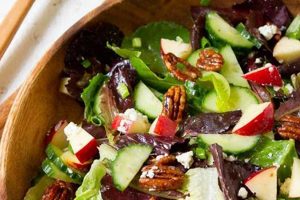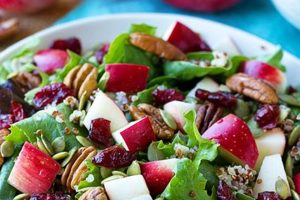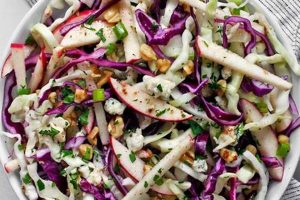A refreshing and often healthful dish, this type of salad combines the sweetness of apples with the crispness of celery. Typically, such a salad incorporates additional ingredients like nuts, dried fruits, and a creamy dressing, often mayonnaise-based. Variations might include grapes, walnuts, and a yogurt-based dressing for a lighter take.
Such salads offer a good source of fiber from both the fruit and vegetable components, contributing to digestive health. The inclusion of other elements like nuts can add protein and healthy fats, making the salad a more balanced and nutritious meal or side dish. Historically, combinations of fruits and vegetables with creamy dressings gained popularity as refrigeration became more widespread, allowing for safe storage and preservation of these ingredients. These salads offered a welcome alternative to heavier dishes, particularly in warmer months.
This exploration will further detail variations in ingredients, dressing preparations, and tips for achieving optimal texture and flavor. Nutritional information, including calorie counts and vitamin content, will be provided. Guidance on selecting the best apples and celery for the salad will also be covered.
Tips for a Successful Apple Celery Salad
Achieving optimal flavor and texture in an apple celery salad requires attention to detail. The following tips offer guidance for creating a satisfying and delicious culinary experience.
Tip 1: Apple Selection Matters Choose crisp, tart apples such as Granny Smith or Honeycrisp. These varieties hold their shape well and offer a pleasant contrast to the celery.
Tip 2: Prevent Browning To prevent cut apples from browning, toss them immediately with a small amount of lemon juice. This helps maintain their fresh appearance.
Tip 3: Celery Preparation is Key Use fresh, crisp celery stalks. Remove any tough strings and slice thinly for optimal texture. Soaking the celery in ice water for a few minutes before adding it to the salad can further enhance its crispness.
Tip 4: Dressing Considerations Mayonnaise-based dressings offer a classic creamy texture, but Greek yogurt or a vinaigrette can provide a lighter alternative. Consider adding a touch of sweetness, such as honey or maple syrup, to complement the tart apples.
Tip 5: Nut and Dried Fruit Enhancements Walnuts, pecans, or dried cranberries provide textural and flavor complexity. Toasting nuts briefly enhances their flavor profile.
Tip 6: Proper Storage Store the salad in an airtight container in the refrigerator. It’s best served chilled, but avoid storing it for extended periods as the apples may soften.
Tip 7: Serve it creatively This salad can be served as a light lunch, a side dish, or even a filling for sandwiches or wraps.
By following these suggestions, one can create a flavorful and texturally appealing salad that balances the sweetness of apples with the savory notes of celery and other complementary ingredients.
These insights provide a foundation for culinary exploration and experimentation within the realm of apple celery salad preparation. The following section will offer concluding thoughts and further resources.
1. Ingredients
Ingredient selection significantly impacts the final character of an apple celery salad. The core components, apples and celery, establish the foundational flavor and texture. Apples contribute sweetness and a degree of tartness, while celery provides a contrasting savory crispness. The specific apple variety influences the overall sweetness and texture; a Honeycrisp offers a sweeter, juicier profile compared to the tartness of a Granny Smith. Similarly, celery’s freshness impacts its crispness and flavor, with older celery potentially exhibiting a tougher, more fibrous texture. Beyond the core ingredients, additions introduce further complexity. Nuts, such as walnuts or pecans, impart richness and textural contrast. Dried fruits, like cranberries or raisins, introduce concentrated sweetness and chewiness. Fresh herbs, such as parsley or dill, contribute aromatic complexity.
Consider the effect of different ingredients on a mayonnaise-based dressing. A sweeter apple, like Fuji, might pair well with toasted pecans and a touch of honey in the dressing. Conversely, a tart Granny Smith apple could complement dried cranberries and a hint of Dijon mustard in the mayonnaise. The interplay of ingredient flavors and textures creates a balanced and nuanced culinary experience. Ignoring ingredient quality can lead to a less satisfying result; for instance, mealy apples will detract from the salad’s overall appeal, while limp celery diminishes its refreshing crispness.
Understanding the role of each ingredient empowers informed choices aligned with desired taste and texture outcomes. Thoughtful ingredient selection elevates a simple combination of apples and celery into a multifaceted culinary creation. This foundational knowledge enables creativity and adaptation within the basic framework of an apple celery salad, resulting in a dish tailored to individual preferences.
2. Preparation Methods
Preparation methods significantly influence the final quality and enjoyment of an apple celery salad. These methods encompass techniques for handling core ingredients, incorporating additional components, and creating the dressing. Consider the impact of knife skills on celery; thinly sliced celery offers a delicate texture, contrasting with thicker cuts that provide more crunch. Dicing apples into uniform pieces ensures even distribution throughout the salad and consistent bite size. Furthermore, understanding the reactivity of cut apples with oxygen necessitates preventative measures. Submerging sliced apples in a solution of lemon juice and water inhibits enzymatic browning, preserving their appealing appearance and preventing flavor degradation.
The order of operations also plays a crucial role. Combining the dressing with more delicate ingredients only immediately before serving prevents them from becoming soggy. For instance, adding toasted nuts or dried cranberries too early can lead to loss of texture and diminished flavor. Similarly, delaying the incorporation of the dressing allows for maintaining the distinct crispness of both apples and celery. Different dressings require specific approaches. A mayonnaise-based dressing might benefit from gradual incorporation of ingredients, whisking continuously to achieve a smooth emulsion. Conversely, a vinaigrette requires vigorous shaking or whisking to combine oil and acidic components effectively.
Mastery of preparation methods ensures a successful outcome. A thoughtfully prepared apple celery salad exhibits balanced flavors, appealing textures, and a visually attractive presentation. Conversely, neglecting these techniques can result in a less satisfying dish with compromised flavor, texture, and appearance. Therefore, understanding and applying appropriate preparation methods is essential for creating a high-quality apple celery salad that maximizes enjoyment and delivers intended culinary results. This attention to detail elevates the simple act of combining ingredients into a demonstration of culinary skill and appreciation for the nuances of flavor and texture.
3. Dressing Choices
Dressing choices profoundly influence the overall flavor profile and character of an apple celery salad. The dressing acts as a unifying element, binding the individual components while contributing its own distinct characteristics. Careful consideration of dressing options allows for customization and enhancement of the salad’s inherent flavors and textures.
- Creamy Dressings
Creamy dressings, often mayonnaise-based, provide a rich, smooth texture that complements the crispness of celery and the sweetness of apples. Variations can include the addition of sour cream, Greek yogurt, or buttermilk for a tangier profile. Incorporating herbs, spices, or flavorings like Dijon mustard or honey further enhances complexity. A classic example is a creamy dressing with mayonnaise, lemon juice, and dill, offering a balance of richness and brightness. However, the heaviness of creamy dressings can sometimes mask the delicate flavors of the other ingredients if used excessively.
- Vinaigrettes
Vinaigrettes offer a lighter, brighter alternative to creamy dressings. Typically composed of oil and vinegar, vinaigrettes provide a refreshing acidity that contrasts with the sweetness of the apple. The choice of oil and vinegar significantly impacts the flavor profile; for instance, a combination of olive oil and apple cider vinegar creates a subtly fruity and tangy dressing. Adding herbs, spices, or a touch of sweetness like maple syrup allows for further customization. Vinaigrettes offer a healthier option, contributing fewer calories and fat compared to creamy dressings, while highlighting the fresh flavors of the salad components. However, the sharpness of some vinaigrettes may not complement all palates or ingredient combinations.
- Yogurt-Based Dressings
Yogurt-based dressings offer a balance between creamy richness and tangy lightness. Greek yogurt provides a thicker consistency and a tangier flavor compared to regular yogurt. These dressings offer a healthier alternative to mayonnaise-based options while still providing a creamy texture. Incorporating ingredients like lemon juice, herbs, and spices allows for customization. A yogurt-based dressing with lemon, dill, and a touch of garlic complements the apple and celery flavors without overpowering them. However, the tanginess of yogurt might not harmonize with all ingredient combinations, particularly those incorporating sweeter fruits.
- Nut-Based Dressings
Nut-based dressings, often made with cashews or almonds, offer a unique creamy texture and rich flavor. Soaking the nuts allows for blending them into a smooth, creamy consistency. These dressings cater to vegan or dairy-free preferences while providing healthy fats and a distinct flavor profile. A cashew-based dressing with lemon juice, garlic, and nutritional yeast offers a creamy, tangy, and savory complement to the salad. However, nut-based dressings can be calorie-dense and might not suit all dietary needs.
The choice of dressing significantly impacts the overall sensory experience of an apple celery salad. Selecting a dressing that complements the other ingredients, balancing flavors and textures, ensures a harmonious and enjoyable culinary result. Careful consideration of dressing options allows for customization and elevates the salad from a simple combination of ingredients to a well-balanced and flavorful dish. The dressing should enhance, not overpower, the inherent flavors of the apple and celery, creating a cohesive and satisfying culinary experience.
4. Flavor Combinations
Flavor combinations play a crucial role in defining the overall sensory experience of an apple celery salad. Balancing contrasting and complementary flavors creates a dynamic and enjoyable culinary experience. Understanding the interplay of sweet, savory, tangy, and acidic elements allows for crafting a salad that caters to specific palates and preferences. The inherent sweetness of apples and the savory crispness of celery provide a foundational flavor profile upon which further complexity can be built. This exploration delves into key flavor combinations commonly employed in apple celery salad recipes.
- Sweet and Savory
The interplay of sweet and savory elements forms a cornerstone of many apple celery salad recipes. The natural sweetness of apples provides a counterpoint to the savory, slightly vegetal notes of celery. This balance can be further enhanced by incorporating ingredients like toasted nuts, which contribute a savory richness, or dried cranberries, which introduce a concentrated sweetness. For example, combining sweet Honeycrisp apples with celery, toasted walnuts, and a Dijon mustard vinaigrette creates a complex flavor profile that balances sweetness, savory notes, and a hint of tanginess. The careful calibration of sweet and savory components prevents either element from dominating, resulting in a harmonious and well-rounded flavor experience.
- Tangy and Acidic
Tangy and acidic elements introduce brightness and complexity to an apple celery salad. Ingredients like lemon juice, vinegar, or yogurt provide a refreshing tartness that cuts through the richness of other components. This acidity can balance the sweetness of apples and enhance the savory notes of celery. For example, a vinaigrette dressing made with apple cider vinegar and lemon juice provides a vibrant acidity that complements the sweetness of Fuji apples and the crispness of celery. Incorporating a tangy element prevents the salad from becoming overly sweet or bland, adding a refreshing dimension to the flavor profile. However, excessive acidity can overpower other flavors; careful balancing is essential for achieving a harmonious result.
- Textural Contrasts
While not strictly a flavor combination, textural contrasts play a significant role in the overall sensory experience. The crispness of celery and apples can be juxtaposed with the crunch of nuts, the chewiness of dried fruits, or the creaminess of a dressing. For instance, combining thinly sliced celery, diced apples, chopped walnuts, and a creamy yogurt dressing provides a variety of textures that enhance enjoyment. The interplay of crisp, crunchy, and creamy elements creates a dynamic mouthfeel that complements the flavor combinations. Attention to textural contrast prevents the salad from becoming monotonous and adds another layer of complexity to the overall sensory experience.
- Aromatic Herbs and Spices
The inclusion of aromatic herbs and spices elevates the flavor profile of an apple celery salad. Fresh herbs like dill, parsley, or chives impart a refreshing green note that complements both apples and celery. Spices like cinnamon or nutmeg can enhance the sweetness of apples and add warmth to the salad. For example, incorporating fresh dill into a yogurt-based dressing enhances the overall freshness and complexity of the salad. The judicious use of herbs and spices can transform a simple salad into a more sophisticated and flavorful dish. However, overpowering the delicate flavors of apples and celery with strong herbs or spices should be avoided.
Understanding and applying these flavor principles allows for creating a customized apple celery salad that balances contrasting elements and caters to individual preferences. Thoughtful consideration of flavor combinations elevates the salad from a simple combination of ingredients to a complex and nuanced culinary creation. By exploring the interplay of sweet, savory, tangy, acidic, and aromatic elements, one can achieve a harmonious and satisfying balance of flavors that enhances the overall dining experience.
5. Nutritional Value
Nutritional value represents a significant factor in the appeal of an apple celery salad recipe. This nutritional content derives primarily from the inherent properties of the core ingredientsapples and celeryand is further influenced by the inclusion of additional components like nuts, dried fruits, and the type of dressing. Apples contribute dietary fiber, vitamin C, and various antioxidants. Celery offers vitamins K and A, along with folate and potassium. The combined nutritional profile promotes digestive health, supports immune function, and contributes to overall well-being. For example, a salad featuring Granny Smith apples, known for their higher fiber content, provides a greater contribution to digestive regularity compared to a salad using a lower-fiber apple variety like Red Delicious. Similarly, incorporating nutrient-dense additions like walnuts, rich in omega-3 fatty acids, further enhances the salad’s nutritional value, contributing to cardiovascular health.
The method of preparation also influences nutritional content. Minimizing processing preserves vitamin content; for instance, consuming the apple with its skin intact retains more fiber and nutrients compared to peeling it. Similarly, choosing a light vinaigrette dressing over a mayonnaise-based alternative reduces overall calorie and fat content, contributing to a lower-calorie meal. Consider the impact of added sugars; using honey or maple syrup in the dressing adds calories and potentially diminishes the health benefits derived from the natural sugars present in the apples. Understanding these factors enables informed choices that maximize nutritional benefits.
Nutritional value adds a dimension of healthfulness to apple celery salad recipes. Awareness of the nutritional composition of individual ingredients and the impact of preparation methods empowers individuals to make informed dietary choices aligned with health goals. Incorporating nutrient-rich variations of this salad into a balanced diet can contribute positively to overall well-being. Recognizing the nutritional value of an apple celery salad extends beyond mere calorie counting; it encompasses understanding the broader health benefits derived from the vitamins, minerals, antioxidants, and fiber inherent in these ingredients. This understanding allows for a more holistic approach to food choices and promotes a deeper appreciation for the role of nutrition in maintaining health and well-being.
Frequently Asked Questions
This section addresses common inquiries regarding apple celery salad recipes, offering concise and informative responses.
Question 1: How can enzymatic browning of apples be prevented after slicing?
Submerging sliced apples in a solution of lemon juice and water inhibits oxidation, preserving their appearance and preventing discoloration.
Question 2: What apple varieties are best suited for this type of salad?
Crisp, tart apples such as Granny Smith or Honeycrisp maintain their texture and provide a desirable flavor contrast. Sweeter varieties like Fuji or Gala can also be used, depending on the desired flavor profile.
Question 3: Can alternative dressings be used instead of mayonnaise-based options?
Vinaigrettes, yogurt-based dressings, or even nut-based dressings offer lighter and potentially healthier alternatives to traditional mayonnaise-based dressings. The choice depends on individual dietary preferences and desired flavor profiles.
Question 4: How long can apple celery salad be stored in the refrigerator?
For optimal quality, consumption within two days is recommended. Storing the salad in an airtight container helps maintain freshness. However, the apples may soften over time.
Question 5: What complementary ingredients can enhance the flavor and texture of the salad?
Nuts such as walnuts or pecans, dried fruits like cranberries or raisins, and fresh herbs like dill or parsley can add complexity and textural variety.
Question 6: Does the nutritional value of the salad change with ingredient variations?
The nutritional content varies based on specific ingredients and dressing choices. For example, incorporating nuts increases healthy fat content, while using a vinaigrette reduces overall calorie intake compared to a creamy dressing.
Understanding these aspects allows for informed choices in crafting an apple celery salad tailored to individual preferences and dietary needs.
The following section will explore various recipe variations and offer detailed preparation instructions.
Apple Celery Salad Recipe
Exploration of this subject has revealed the multifaceted nature of constructing a successful apple celery salad recipe. Key factors, including ingredient selection, preparation methods, dressing choices, and flavor combinations, contribute significantly to the final product. Understanding the interplay of these elements allows for informed decision-making, enabling creation of a salad tailored to specific preferences. Nutritional considerations further enhance appreciation for the health benefits inherent in combining apples and celery with complementary ingredients. Attention to detail in each preparatory stage, from apple selection to dressing preparation, ultimately determines the overall culinary experience.
The simplicity of an apple celery salad recipe belies its potential for culinary creativity. Thoughtful ingredient selection, precise preparation techniques, and a nuanced understanding of flavor combinations elevate this seemingly basic dish into a versatile and satisfying culinary creation. Continued exploration of flavor profiles and ingredient combinations offers boundless opportunities for innovation within this classic framework. Ultimately, mastery of this recipe empowers individuals to craft a refreshing, nutritious, and flavorful dish that contributes positively to a balanced and enjoyable dietary experience.






